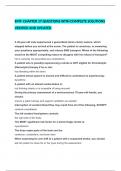-
1. Exam (elaborations) - emt final exam questions with correct answers latest update questions with complete ...
-
2. Exam (elaborations) - West coast emt block #2 exam questions and answers graded a+
-
3. Exam (elaborations) - West coast emt block #2 exam questions with correct answers graded a+
-
4. Exam (elaborations) - West coast emt block 2 exam questions with complete solutions graded a++
-
5. Exam (elaborations) - West coast emt block exam questions and answers with complete solutions verified!!!
-
6. Exam (elaborations) - West coast emt block #2 exam questions and answers with complete solutions graded a++
-
7. Exam (elaborations) - West coast emt block 2 exam questions and answers
-
8. Exam (elaborations) - West coast emt block #2 exam questions with correct complete solutions graded a++
-
9. Exam (elaborations) - West coast emt block 2 exam questions with complete solutions
-
10. Exam (elaborations) - West coast emt block 1 exam questions and answers with complete solutions
-
11. Exam (elaborations) - west coast emt block #2 exam topics questions and answers
-
12. Exam (elaborations) - West coast emt block 2 questions and answers with complete solutions
-
13. Exam (elaborations) - West coast emt block #1 exam questions and complete verified answers graded a++
-
14. Exam (elaborations) - West coast emt block 5 exam questions and complete solutions verified
-
15. Exam (elaborations) - West coast emt - block 5 exam questions and verified correct answers
-
16. Exam (elaborations) - West coast emt block 2 study guide questions and answers updated
-
17. Exam (elaborations) - West coast emt block 4 quiz questions with complete solutions
-
18. Exam (elaborations) - West coast emt block 2 quiz and correct answers with complete solutions verified
-
19. Exam (elaborations) - West coast emt final exam questions and answers with complete solutions graded a++
-
20. Exam (elaborations) - West coast emt block 4 exam study guide questions and verified answers explained
-
21. Exam (elaborations) - Emt midterm exam jb learning questions and verified answers updated 2024
-
22. Exam (elaborations) - Emt final-jb learning exam actual questions with complete verified correct answers gr...
-
23. Exam (elaborations) - Jb learning: emt final exam 2024 questions with complete solutions verified answers 1...
-
24. Exam (elaborations) - Emt exam 4 jb learning questions with verified correct answers by experts
-
25. Exam (elaborations) - Emt unit 2 exam jb learning questions with correct verified answers graded a++ alread...
-
26. Exam (elaborations) - Jb learning emt final exam questions and verified answers updated already passed
-
27. Exam (elaborations) - Emt chapter 36 jb learning questions with complete solutions verified 100% guaranteed...
-
28. Exam (elaborations) - Emt chapter 17 jb learning exams questions with verified correct answers updated 2024
-
29. Exam (elaborations) - Emt chapter 22 jb learning exams questions with complete solutions verified
-
30. Exam (elaborations) - jb learning emt exam part 2 latest questions with complete solutions verified graded...
-
31. Exam (elaborations) - Emt chapter 24 jb learning exam questions with complete verified correct answers
-
32. Exam (elaborations) - emt chapter 26 jb learning exams questions with complete solutions updated
-
33. Exam (elaborations) - Emt chapter 38 jb learning exam questions with complete solutions verified already pa...
-
34. Exam (elaborations) - jb learning emt exam 3 latest questions with complete verified correct answers updat...
-
35. Exam (elaborations) - emt midterm exam study guide questions and verified correct answers
-
36. Exam (elaborations) - Midterm exam emt questions with correct verified answers
-
37. Exam (elaborations) - emt final exam latest actual questions with complete verified correct answers graded...
-
38. Exam (elaborations) - Chapter 39 emt exam questions with complete solutions answered correctly and verified
-
39. Exam (elaborations) - emt-b scenarios exam questions and complete solutions verified graded a++
-
40. Exam (elaborations) - Emt national registry 2024 exam questions with complete verified correct answers
-
41. Exam (elaborations) - emt chapter 1 exam questions with complete solutions verified
-
42. Exam (elaborations) - Emt- chapter 17 questions with complete solutions verified and updated
-
43. Exam (elaborations) - Chapter 5 emt exam questions and verified answers (150 questions and answers ) with c...
-
Show more




